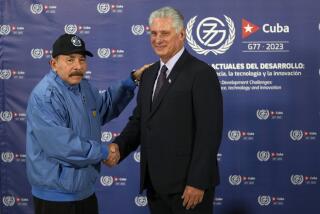Making It Tough for Peace
- Share via
President Reagan argues that the Central American peace plan is “fatally flawed,” and that the response of the Sandinista government of Nicaragua is “only show.” We think that he is wrong. We are encouraged in our view by his failure to provide substance to support his contention. Indeed, he seems to be interested primarily in wrecking the plan before it can have a fair test. His eagerness to find fault and the relish with which he anticipates failure have raised doubts throughout the hemisphere as to his commitment to peace.
The President launched his latest attack on the peace plan of the five nations of Central America just three days after President Oscar Arias Sanchez of Costa Rica had, in a personal visit to the White House and in an eloquent appeal to a joint session of Congress, asked for time to test the initiative. He was its principal architect. He leads the oldest of the Latin democracies.
“It is time to focus on the positive,” Arias told Congress. “War signifies the failure of politics. Let us restore faith in dialogue and give peace a chance.”
If Arias’ counsel was not heeded in the White House, it was heard and understood in Managua, where the Sandinistas accelerated in succeeding days the implementation of the reforms that are required by the Aug. 7 peace plan. And it was heard in San Salvador, where a new dialogue to end the civil war in El Salvador will commence next weekend.
The events of the weekend were instructive. Nicaragua opened its border with Honduras to permit exiles to accept the amnesty now offered them. Few came, but some came. Through the streets of Managua itself, 3,000 opponents of the Sandinistas marched in a peaceful demonstration authorized by the government. Final preparations were made for La Prensa to resume publication without censorship, and for Radio Catolica to return to the air.
All that, of course, falls short of the American-style democracy that White House staff members say is now what Reagan wants for Nicaragua. This is a test that, of all Central American nations, only Costa Rica could pass. But it also appears to be a convenient device for Reagan to use in trying to eliminate the Sandinistas, whom he sees solely as Marxist allies of Havana and Moscow. In his determination to do that, Reagan appears troubled by the peace proposals while remaining curiously confident that the kind of Nicaragua that he wants can be achieved only with contra bullets and continuation of a war that has already taken 30,000 lives. His visible distrust of what the Central Americans themselves are trying to do makes it all the more difficult for them--leaders like Arias--to tame the extremism of the Sandinistas.
The tentative, timid steps being taken along the path to peace in Nicaragua will be paralleled in El Salvador during the weekend with another meeting between President Jose Napoleon Duarte and the rebels. This confrontation also will test the potential of the peace plan to replace warfare with negotiations. The agenda, according to an official of the Roman Catholic Church, “will be everything that has to be done to arrive at an end to hostilities.”
Six weeks remain before the first important deadline in the peace process. Those leading the way, like lonely soldiers making their way through a minefield, need encouragement, not disparaging cynicism. That is why those genuinely concerned about peace are on their side.
More to Read
Sign up for Essential California
The most important California stories and recommendations in your inbox every morning.
You may occasionally receive promotional content from the Los Angeles Times.













